
- Home
- Travel Packages
- Top Destination
-
Travel Attraction
By Category
Top Attraction

- Travel Agents
- Car Rentals
- Hotels
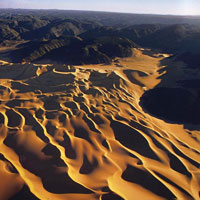
Agadir, located on Morocco’s southern Atlantic coast, is a modern and vibrant city known for its stunning beaches, pleasant climate, and dynamic tourism industry. Rebuilt after a devastating earthquake in 1960, Agadir has transformed into one of Morocco’s leading seaside destinations, blending contemporary architecture with relaxed coastal charm. The city’s layout is modern and spacious, featuring wide boulevards, seaside promenades, and numerous hotels, cafés, and resorts that cater to both local and international visitors. Agadir’s 10-kilometer sandy beach and year-round sunshine make it a popular spot for swimming, surfing, and other water sports. The city also serves as a gateway to the Souss-Massa region, known for its natural parks, Amazigh (Berber) culture, and scenic landscapes. Historical attractions include the Kasbah of Agadir Oufella, offering panoramic views of the coastline, and the bustling Souk El Had, a marketplace rich with local crafts, spices, and produce. Economically, Agadir thrives on tourism, fishing, and agriculture, particularly citrus and argan oil production. With its blend of leisure, culture, and modern amenities, Agadir presents a unique contrast to Morocco’s historic cities, offering a more relaxed and contemporary coastal experience while still reflecting the country’s rich traditions and warm hospitality.
Explore More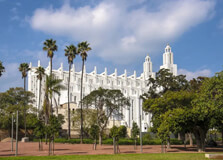
Casablanca, Morocco’s largest city and economic capital, is a bustling metropolis located along the country’s Atlantic coast. Known for its cosmopolitan atmosphere and modern infrastructure, Casablanca serves as Morocco’s main financial, industrial, and commercial hub. The city’s port is one of the largest in Africa, supporting vibrant trade and maritime industries that drive much of the national economy. Casablanca seamlessly blends tradition with modernity. While it is home to towering skyscrapers, luxury hotels, and international businesses, it also preserves elements of Morocco’s cultural heritage. The iconic Hassan II Mosque, one of the largest mosques in the world, stands as a masterpiece of Islamic architecture overlooking the sea. The city’s old medina offers a glimpse of traditional Moroccan life, contrasting with the chic districts of Maarif and Ain Diab, known for shopping, dining, and nightlife. Culturally diverse and fast-paced, Casablanca attracts both locals and expatriates seeking opportunity and urban sophistication. It is also an important center for art, film, and design, reflecting Morocco’s evolving identity. With its coastal charm, economic vitality, and cultural richness, Casablanca represents the modern face of Morocco—a city where innovation meets heritage in a dynamic and ever-evolving environment.
Explore More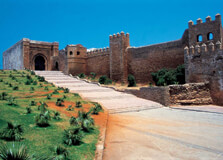
Rabat, the capital city of Morocco, lies gracefully along the Atlantic coast at the mouth of the Bou Regreg River. Known for its calm atmosphere, clean streets, and elegant blend of history and modernity, Rabat serves as the political and administrative heart of the country. It is home to Morocco’s royal palace, government institutions, and numerous foreign embassies, making it an important center of governance and diplomacy. Founded in the 12th century by the Almohads, Rabat boasts a rich historical heritage reflected in its impressive landmarks, such as the Hassan Tower, the Mausoleum of Mohammed V, and the Kasbah of the Udayas—a picturesque fortress overlooking the ocean. The city’s medina, a UNESCO World Heritage Site, offers a charming mix of traditional markets and Andalusian architecture. Beyond its historical core, Rabat is a modern and well-planned city, featuring green spaces, wide boulevards, and cultural institutions such as the Mohammed VI Museum of Modern and Contemporary Art. Its coastal location and mild climate make it a pleasant place to live and visit. Combining historical depth, political significance, and a refined urban lifestyle, Rabat stands as one of Morocco’s most balanced and sophisticated cities, symbolizing the nation’s progress and cultural pride.
Explore More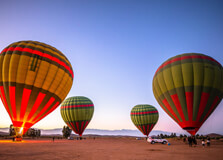
Marrakech, often called the “Red City” for its distinctive terracotta architecture, is one of Morocco’s most captivating and historic destinations. Founded in the 11th century by the Almoravid dynasty, it has long been a political, cultural, and economic hub in North Africa. Situated at the foothills of the Atlas Mountains, Marrakech enchants visitors with its vibrant atmosphere, rich traditions, and architectural splendor. At the heart of the city lies the bustling Medina, a UNESCO World Heritage Site filled with winding alleys, colorful souks, and lively squares. The famous Jemaa el-Fnaa square serves as the cultural epicenter, where storytellers, musicians, and food vendors create an unforgettable sensory experience. Iconic landmarks such as the Koutoubia Mosque, Bahia Palace, and the Saadian Tombs highlight the city’s deep historical roots. Beyond its heritage, modern Marrakech offers luxury resorts, contemporary art galleries, and fine dining, making it a favorite destination for travelers seeking both tradition and sophistication. The city’s unique blend of old-world charm and modern energy captures the essence of Morocco’s cultural diversity. Whether exploring its ancient streets or relaxing in a traditional riad, visitors find Marrakech to be a city of warmth, color, and timeless allure.
Explore More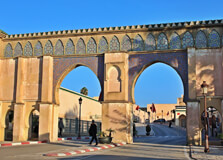
Meknes, one of Morocco’s four imperial cities, is a historic gem located in the north-central part of the country, near the fertile plains of the Middle Atlas Mountains. Founded in the 11th century by the Almoravids, the city rose to prominence under Sultan Moulay Ismail in the 17th century, who transformed it into a grand imperial capital adorned with monumental gates, palaces, and gardens. Often called the “Versailles of Morocco,” Meknes reflects the sultan’s ambition and architectural vision. The city’s medina, a UNESCO World Heritage Site, showcases a harmonious blend of Islamic and European styles. Notable landmarks include the imposing Bab Mansour gate, the royal stables, the Mausoleum of Moulay Ismail, and the vast Heri es-Souani granaries. Meknes’s charm lies in its quieter, more authentic atmosphere compared to the busier tourist centers of Marrakech or Fes. Today, Meknes remains an important cultural and agricultural hub, surrounded by olive groves and vineyards. Its proximity to the ancient Roman ruins of Volubilis adds further historical depth. Combining imperial grandeur, traditional Moroccan character, and a relaxed pace of life, Meknes offers visitors a captivating journey through Morocco’s rich past and enduring architectural splendor.
Explore More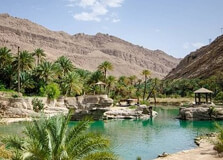
Ouarzazate, often referred to as the “Gateway to the Desert,” is a striking city located in south-central Morocco, where the High Atlas Mountains meet the vast Sahara. Known for its dramatic landscapes, ancient architecture, and cinematic allure, Ouarzazate has become a cultural and tourism hub as well as a center for Morocco’s growing film industry. Historically, the city developed as a strategic trading post linking sub-Saharan Africa with northern Morocco. Its name, derived from the Amazigh language, means “without noise,” reflecting its peaceful desert setting. Among its most famous landmarks is the UNESCO-listed Aït Ben Haddou, an ancient ksar (fortified village) made of earthen clay that has appeared in numerous films and series. Other highlights include the Taourirt Kasbah, once home to a powerful local dynasty, and the Atlas Film Studios, one of the largest in the world. Ouarzazate serves as a gateway to breathtaking natural sites such as the Draa Valley, the Todra Gorges, and the Sahara dunes. The region’s distinctive blend of Amazigh culture, traditional architecture, and cinematic history creates a unique atmosphere. With its clear skies, desert charm, and sense of timelessness, Ouarzazate captures the spirit of Morocco’s southern frontier and its enduring beauty.
Explore More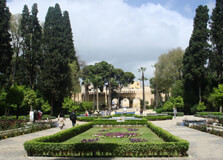
Fes, often regarded as the spiritual and cultural heart of Morocco, is one of the country’s oldest and most historically significant cities. Founded in the 9th century, it served as a former capital and remains a vibrant center of Islamic scholarship, craftsmanship, and tradition. The city is renowned for its well-preserved medieval architecture, bustling souks, and deep-rooted cultural heritage. At the core of Fes lies the ancient Medina of Fes el-Bali, a UNESCO World Heritage Site and one of the world’s largest car-free urban areas. Its maze of narrow alleys is filled with mosques, madrasas, artisan workshops, and traditional tanneries, offering a glimpse into centuries-old Moroccan life. Notable landmarks include the **University of Al Quaraouiyine**, considered the world’s oldest continually operating university, and the beautiful **Bou Inania Madrasa**, a masterpiece of Marinid architecture. Fes is divided into three main areas: the old medina (Fes el-Bali), the newer Fes el-Jdid, and the modern Ville Nouvelle, reflecting its evolution through time. The city’s atmosphere is deeply traditional yet intellectually vibrant, making it a hub for culture, religion, and craftsmanship. With its rich history and enduring authenticity, Fes embodies the soul of Morocco and continues to inspire travelers and scholars alike.
Explore More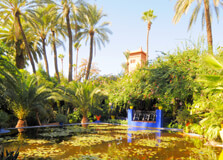
Marrakesh, known as the “Red City” for the distinctive hue of its walls and buildings, is one of Morocco’s most iconic and enchanting destinations. Founded in the 11th century by the Almoravid dynasty, it has long stood as a crossroads of trade, culture, and art in North Africa. Nestled at the foot of the Atlas Mountains, Marrakesh captivates visitors with its vibrant energy, historical depth, and architectural beauty. The city’s historic heart, the **Medina of Marrakesh**, is a UNESCO World Heritage Site filled with winding alleys, bustling souks, and centuries-old monuments. The **Jemaa el-Fnaa** square, alive with storytellers, musicians, and food vendors, embodies the city’s pulsating spirit. Landmarks such as the **Koutoubia Mosque**, **Bahia Palace**, and **Saadian Tombs** showcase Marrakesh’s rich Islamic and Moroccan architectural heritage. Modern Marrakesh complements this tradition with luxury hotels, contemporary art galleries, and fine dining, particularly in the districts of Gueliz and Hivernage. The city’s lush gardens, like the **Majorelle Garden**, offer peaceful retreats amid the urban bustle. Combining old-world charm with modern sophistication, Marrakesh remains a symbol of Moroccan culture—a city of color, creativity, and timeless allure that continues to inspire travelers from around the world.
Explore More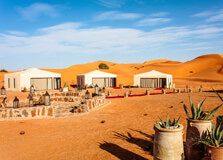
Merzouga is a small village located in southeastern Morocco, near the border with Algeria, famous as the gateway to the vast Erg Chebbi dunes—some of the tallest and most spectacular sand dunes in the Sahara Desert. This remote desert oasis offers visitors a unique chance to experience the breathtaking beauty and timeless mystique of the Sahara. The towering golden dunes of Erg Chebbi, reaching up to 150 meters high, create a stunning landscape that changes dramatically with the shifting light throughout the day. Merzouga is popular among tourists seeking authentic desert adventures, including camel treks, 4x4 excursions, and overnight stays in traditional Berber-style tents under the star-filled desert sky. These experiences provide a deep connection to the local culture and the natural environment. Though small, Merzouga serves as a hub for desert tourism, offering accommodations ranging from simple guesthouses to luxury camps. The village also reflects the Berber culture and lifestyle, with its friendly local inhabitants and traditional music and crafts. Merzouga’s serene desert environment, combined with its dramatic landscapes, makes it an unforgettable destination for those wanting to explore Morocco beyond its cities—immersing themselves in the Sahara’s vastness and tranquility.
Explore More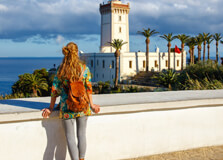
Tangier, located at the strategic crossroads where the Mediterranean Sea meets the Atlantic Ocean, is a vibrant port city in northern Morocco with a rich and diverse history. Known as the “Gateway to Africa,” Tangier has been a cultural melting pot for centuries, influenced by Phoenician, Roman, Arab, and European civilizations. Its unique blend of African, European, and Arab cultures gives the city a cosmopolitan and eclectic atmosphere. The city’s historic **Kasbah** overlooks the Strait of Gibraltar and offers panoramic views of both the Mediterranean and Atlantic waters. Tangier’s old medina is a maze of narrow streets filled with markets, cafes, and historic buildings, reflecting its centuries-old heritage. The **American Legation Museum**, the only US National Historic Landmark located outside the United States, highlights the city’s long-standing diplomatic ties. Tangier’s coastline features beautiful beaches and a modern marina, attracting tourists and locals alike. The city also has a thriving arts scene, with galleries, music festivals, and literary events celebrating its bohemian past—once frequented by famous writers and artists like Paul Bowles and William S. Burroughs. Today, Tangier is rapidly modernizing while maintaining its historic charm, making it a dynamic destination where history, culture, and modernity converge on Morocco’s northern shore.
Explore More
Dakhla is a unique and rapidly growing city located on a narrow peninsula in the disputed region of Western Sahara, along the Atlantic coast of southern Morocco. Known for its stunning natural landscapes, Dakhla has become a top destination for eco-tourism and adventure sports, especially kite surfing and windsurfing, thanks to its consistent winds, warm climate, and pristine beaches. The city is surrounded by vast desert dunes on one side and the calm, turquoise waters of the Dakhla Bay on the other, creating a striking contrast between sand and sea. Dakhla’s lagoon is considered one of the best spots in the world for water sports, attracting enthusiasts from across the globe. Beyond its appeal to surfers, the area is rich in biodiversity, including flamingos and other migratory birds, making it a paradise for nature lovers and bird watchers. Though relatively remote, Dakhla is developing quickly with improved infrastructure, eco-friendly resorts, and cultural centers showcasing Saharan Berber heritage. The city offers a peaceful escape from urban life and a chance to explore the Sahara’s serene beauty. Dakhla’s combination of adventure, natural wonders, and authentic local culture makes it an increasingly popular and unforgettable destination in Morocco’s southern frontier.
Explore More
Beni Mellal is a vibrant city situated in the heart of Morocco’s fertile Tadla Plain, nestled at the foot of the Middle Atlas Mountains. Known as the “Gateway to the Middle Atlas,” the city serves as an important agricultural and commercial hub, benefiting from its strategic location and abundant natural resources. Beni Mellal is famous for its lush landscapes, especially its expansive olive groves, citrus orchards, and rich farmlands. One of the city’s most notable landmarks is the historic Kasbah of Beni Mellal, perched on a hill overlooking the city, ffering panoramic views of the surrounding plains and mountains. The nearby Ain Asserdoun spring and Ouzoud Waterfalls, one of Morocco’s most beautiful natural sites, attract visitors seeking nature and tranquility. Beni Mellal’s economy revolves around agriculture, trade, and increasingly tourism, with growing interest in ecotourism and outdoor activities such as hiking and mountain biking. The city blends traditional Moroccan culture with a developing urban lifestyle, offering markets, restaurants, and cultural festivals that celebrate its Amazigh (Berber) heritage. With its scenic surroundings, agricultural significance, and warm local hospitality, Beni Mellal provides a peaceful yet lively glimpse into Morocco’s rural heartland, making it an appealing destination for travelers exploring the country’s diverse landscapes beyond the major cities.
Explore MoreMarrakesh Tour Package 5D - 4N
5 Days/ 4 Night
Marrakesh
Dharamshala Dalhousie Tour
8 Days/ 7 Night
New Delhi - Shimla - Manikaran - Manali - Bir Moghrein - Marrakesh
Viagem 10 Dias de Casablanca,Deserto Do Saara E Cidades Imperiais
10 Days/ 9 Night
Casablanca - Chefchaouen - Meknes - Merzouga - Marrakech
8 Days Desert Tour To Marrakech
8 Days/ 7 Night
Marrakech
Morocco is officially known as the Kingdom of Morocco. Among the North African countries, the Kingdom of Morocco is most westerly. Morocco has an interesting history of independence which is unique. The amalgamation of Berber, Arab, African and European influences makes its rich culture.
Moroccan Dirham (MAD)
446,550 square km
32,644,370 (2012 estimate)
Moroccan Arabic
+212
WET (UTC+0)
WEST (UTC+1)
The climate in Morocco is Mediterranean in the North. However, it becomes more extreme towards the interior regions. 12% of the land is covered by forests. 18% of the land is arable out of which 5% is irrigated. The country has Atlas mountain range which not only divides the country into different terrains but also cause a variation in climatic zones. Several different climates like Mediterranean and Maritime Temperate allow different species of oaks, junipers, carpets, Atlantic cedars and many other plants. This leads to the formation of very extensive and rich humid cloud forests. On the other side there is the big Sahara desert. Here, the interesting features are oasis, sand dunes and rocky desert landscapes.
Territory and Capital : Apart from having Mediterranean and Atlantic coastlines, it also has a rugged mountain interior. Most of the region is mountainous. The center and south portion of the country is mainly occupied by Atlas Mountains. Rabat is the political capital of Morocco.
Suitable Visiting Seasons : The spring season in the months of April and May and autumn season in the months of September and October is the best time to visit Morocco weather-wise. It is an amazing experience to explore the country during this year and the weather also remains pleasant.
Morocco’s marine transport is dynamic with tourist oriented approach. The other modes of transport such as railways, roads/highways and airways are also in a very good shape and infrastructure.